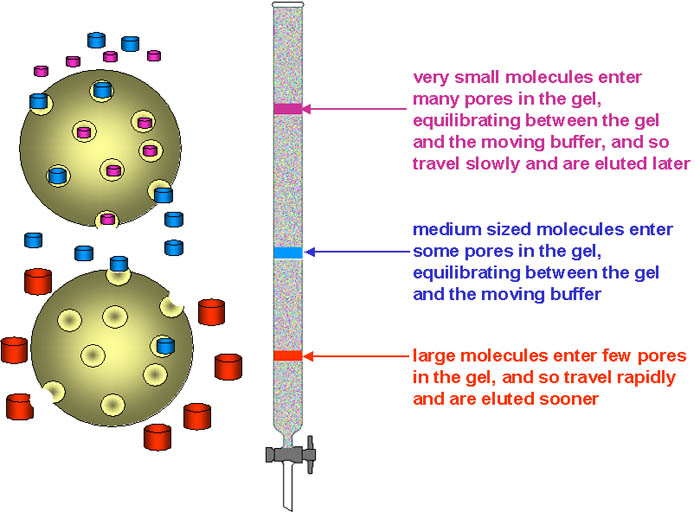
Proteins (and other macromolecules) can be separated by their size by chromatography on columns of beads of gel that have small pores, so that smaller molecules spend more time within the pores of the support medium, and hence move more slowly, than larger molecules. This is the technique of gel exclusion chromatography, also know as gel filtration or gel permeation chromatography. By adding a series of coloured markers of known molecular mass to the sample undergoing chromatography, it is possible to calibrate the column, and hence estimate the molecular mass of the enzyme, by comparison of its elution volume with those of the standard markers.
Large molecules travel faster, and hence elute earlier from the column.

The media used for gel exclusion chromatography include dextran (Sephadex™), polyacrylamide (Bio-Gel P™) and dextran-polyacrylamide (Sephacryl™) and agarose (Sepharose™ and BioGel A™). Each is available with a variety of different ranges of pore size in the beads, permitting separation of macromolecules of different size.
A gel with a smaller range of pore sizes (and hence a smaller range over which it can separate macromolecules on the basis of their size) will give a higher resolution; a gel with a wider range will give lower resolution, but will permit fractionation of a larger range of sizes as an initial step when the approximate molecular mass of the enzyme is not known.
The particle size of the gel beads (the mesh size) also affects resolution; smaller beads permit higher resolution, but a lower flow rate through the column (and hence a slower separation).
The table shows the useful range for the most commonly used gel filtration media - the lower and upper molecular sizes (in kDa) over which they can be used to separate macromolecules. The upper limit is known as the exclusion limit of the gel - the size above which proteins will elute in the void volume of the column.
| lower limit | upper limit | |
| dextran gels | ||
| Sephadex G-50 | 1.5 | 30 |
| Sephadex G-75 | 3 | 80 |
| Sephadex G-100 | 4 | 150 |
| Sephadex G-150 | 5 | 300 |
| Sephadex G-200 | 5 | 600 |
| polyacrylamide gels | ||
| Bio-Gel P-10 | 1.5 | 20 |
| Bio-Gel P-30 | 2.5 | 40 |
| Bio-Gel P-60 | 3 | 60 |
| Bio-Gel P-100 | 5 | 100 |
| Bio-Gel P-150 | 15 | 150 |
| BioGel P-200 | 30 | 200 |
| Bio-Gel P-300 | 60 | 400 |
| dextran-polyacrylamide gels | ||
| Sephacryl S-200 | 5 | 250 |
| Sephacryl S-300 | 10 | 1500 |
| Sephacryl S-400 | 20 | 8000 |
| agarose gels | ||
| Sepharose 6B | 10 | 4000 |
| Sepharose 4B | 60 | 20,000 |
| Sepharose 2B | 70 | 40,000 |
| Bio-Gel A-0.5 | 10 | 500 |
| Bio-Gel A-1.5 | 10 | 1500 |
| Bio-Gel A-5 | 10 | 5000 |
| Bio-Gel A-15 | 40 | 15,000 |
| Bio-Gel A-50 | 100 | 50,000 |